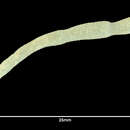fr
noms dans le fil d’Ariane


"Melicerita digeronimoi sp. nov.
P1. 1. Figs. 1-6
Erect, calcareous colony, unarticulated, nodulate, bilaminar, flattened, slightly curved in a sabre shape, with a lengthwise ridge along the two lateral margins, anchored to the substratum by means of chitinous rootlets.
Autozooids regularly hexagonal, as long as wide, with raised (lengthwise straight, proximally concave and distally convex) edges (Plate I; Fig. 1), arranged in alternate transverse rows, each made up of 2-3 zooids and terminating, on the convex margin of the colony, either an avicularium or an autozooid which alternate. Cryptocyst finely granular, strongly sloping near the edges but rather flat centrally, marked by two uniformly raised longitudinal ridges developing for nearly the entire length of the autozooids, between the opesium and its lateral edges (Plate I, Figs. 1 ,4, 6). Aperture in the distal third of the autozooid, near the distal end (Plate I, Figs. 1, 4, 6), semicircular with an arched distal border and a straight proximal one, extending in a very large and flat rectangular prominent, slightly crenellate, process leaving two marked lateral indentations (Plate I, Figs. 3, 4, 6). The lateral ends of this process seem to be folded inside to form two acuminate, slightly diverging condyles (Plate I, Figs. 4, 6). Opesial rim thin and slightly raised and crenellate (Plate I, Fig. 6).
Ovicell endothoical, completely immersed, indicated outside by a semi circular ooeciopore (1/3 width of the opesium) situated along the distal end of the zooid, and by two latero-proximal, symmetrical, subelliptical, crenellate pores (Plate I, Figs. 1-3). Only in later ontogeny the ovicell become evident as a slight, moderate swelling of the proximal part of the distal row of zooids (Plate I, Fig. 2).
Vicarious avicularia, roughly as large as 1/2 autozooid, irregularly quadrangular, exclusively located along the convex margin of the colony, in alternate rows on each side of the lateral ridge (Plate I, Figs. 1, 4). Cryptocyst finely granular, depressed, with a subcentral opesium, proximally marked by a semi-circular or semi-elliptical, sometimes very oblong, ridge (Plate I, Fig. 5). Distal rostrum raised, supporting a semi-elliptical arched mandibula, wider than long (Plate I, Fig. 5a), with a proximal tongue inserted in the proximal foramen separated by two stout condiles from the ]arger, distal one (Plate I, Fig. 5b).
One single subtriangular kenozooid observed at the nodal level; the opesium a small, subcentral, rounded angles triangle.
The basal rootlets were detached from the colony, but probably originated from the proximal portion of the frontal wall of some basal zooids.
Derivatio nominis: From Prof. Sebastiano Italo Di Geronimo, Coordinator of the Benthos sector for the P.N.R.A. (National Programme of Antarctic Research).
DIMENSIONS
(10 measurements; in t) MIN MAX MEAN S. D. Zooidal Length 625 775 695 55,09 Zooidal Width: 600 700 669 34,98 Opesium Length 113 150 133 13,26 Opesium Width 200 300 263 28,99 Avicularium Length 375 600 488 89,95 Avicularium Width 200 350 281 42,19
Holotype deposited in the Instituto Policattedra di Oceanologia e Paleoecologia Museum: IPOP. B 1 . 8.8.1991. Catania, Italia." (Rosso, 1992)
Melicerita digeronimoi is een mosdiertjessoort uit de familie van de Cellariidae.[1] De wetenschappelijke naam van de soort is voor het eerst geldig gepubliceerd in 1992 door Rosso.
Bronnen, noten en/of referenties